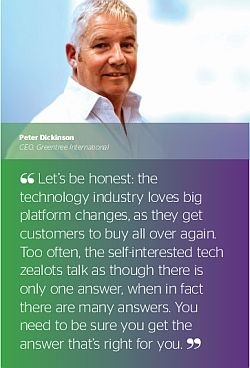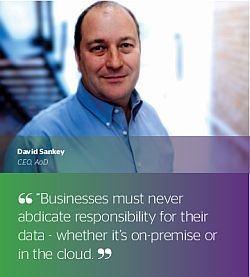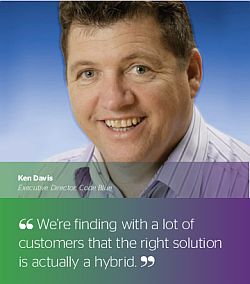Published on the 03/02/2012 | Written by Peter Dickinson

When it comes to computing solutions, it’s what they do – not how they’re delivered – that really counts. Duncan Campbell from ERP solutions provider Greentree takes a closer look at hosting ERP solutions in the cloud…
“We’re moving to the cloud!’ “Let’s be honest,” says Dickinson, “the technology industry loves big platform changes, as they get customers to buy all over again. Too often, the self-interested tech zealots talk as though there is only one answer, when in fact there are many answers. You need to be sure you get the answer that’s right for you.” Cloud is inevitably on the agenda today for any business looking at significant computer hardware expenditure. An on-premise server is an expense that needs careful analysis to ensure that it’s an investment rather than a liability. You have to factor in the ongoing maintenance costs, and whether it has the capacity to add more software if new functions are required. And whatever you buy, it’s going to have a finite life span. Equipment obsolescence is a major selling point for cloud vendors. ‘Get your computing from us’, they say, and kiss your hardware problems goodbye. ‘Upgrades and replacements are our problem, not yours’. ‘The only hardware you deal with is the means by which you access your data and applications. And what’s more: you can access them anywhere, from any web capable device! You don’t need that great big expensive server in your office; you probably only use a fraction of its capacity anyway. With the cloud, you get (and pay for) just what you need!’ Sounds great, doesn’t it – the convenience and the flexibility? Dickinson uses the analogy of driving your car versus catching the bus. But as he points out: some days you need your car because the bus doesn’t suit. “There are a lot of instances where you don’t just want to go from A to B; you want to go from A to B and you want to pick up a package from C on the way, or you want to leave at 7.30 rather than 7.24,” he says. “You want to be in control of what you’re doing, and the bus doesn’t always give you that.” Dickinson emphasises that Greentree is cloud-agnostic. “We have customers that run on-premise, and others in public or private clouds, and we offer shared software models as well,” he says. “The choice is entirely up to the customer.” Another cloud question for businesses is: ‘do I want a cloud resource that is mine, or am I happy to share with lots of others?’ Setting up your own ‘private cloud’ infrastructure is going to cost you more, but the financial benefits must be balanced against such factors as loss of control. The private cloud is your resource and you can manage it as you want. The public cloud is a shared resource which the host will manage, and therefore your priorities will be balanced against those of many others. If you also decide to opt for Software-as-a-Service, or SaaS, rather than buy a software licence, what you save on capital costs may be exceeded over time by your monthly rental fees. In addition, SaaS offerings tend to have limitations. While it’s convenient not having to manage upgrades, these will instead be in the control of the provider, and you may not get the functionality you want, when you want it. “You generally have to _it in with what they’ve got available,” says Dickinson. One size doesn’t fit all Medium sized businesses are increasingly taking advantage of cloud services like Google’s Gmail and Microsoft’s Office 365 suite. Cloud mail currently holds between three and four per cent of the enterprise email market, and researcher Gartner predicts this will rise to 20 per cent by year-end 2016. So, what functions aren’t ready yet for the cloud? “I’m firmly in the camp that file & print, for example, is going to be on-premise for a long, long time,” says Davis. Seeking the best fit Bandwidth also becomes important for speed of access to certain functions. “People tend to think about web performance in terms of websites,” says Sankey. “They’ll be somewhat patient in terms of a website loading, but a data entry person won’t be patient when they’re trying to hammer through 100 sales orders.” Remember too, that a cloud system is dependent on the internet connection, creating another potential point of failure. If you’ve only got one internet connection, you must seriously consider establishing a second, preferably with a different ISP. Therefore, when seeking a best-_it computing solution, draw up a transition plan and ensure you get a cost analysis of cloud versus on-premise – get it broken down by each application if necessary, to determine what the right strategy is for your business. The vendor can satisfactorily answer the questions in the box below, is probably the one for you.
You hear that a lot in the business world today: cloud is the buzz word, cloud is the future – it’s here now, and before long it’s going to be where all data is stored, and where all business applications are hosted.
But is that the reality? If you’re looking at a significant computing upgrade, should the cloud be your first option? Will a wholly cloud-based system suit your needs? Or are there some functions that are still better performed by computers on-premise? Peter Dickinson, CEO of Greentree, Ken Davis, Executive Director of Greentree’s New Zealand cloud services partner CodeBlue, and David Sankey, CEO of Australian cloud partner AoD, say businesses need to be properly prepared when considering cloud computing, and they need to ask some hard questions of vendors, to ensure they get the right solution.
Peter Dickinson, CEO of Greentree, Ken Davis, Executive Director of Greentree’s New Zealand cloud services partner CodeBlue, and David Sankey, CEO of Australian cloud partner AoD, say businesses need to be properly prepared when considering cloud computing, and they need to ask some hard questions of vendors, to ensure they get the right solution.
Is the cloud right for me? Then let’s not forget that back in April of this year, Amazon’s data centre suffered a major outage that left quite a few global websites out of action for days. “There seems to be a lot of sales pitches that the cloud totally eliminates risk. To me this is an illusion, until the disaster that nobody predicted happens,” says Sankey. “Such incidents also drive home the message that businesses must never abdicate responsibility for their data – whether it’s stored on premise or in the cloud.”
Then let’s not forget that back in April of this year, Amazon’s data centre suffered a major outage that left quite a few global websites out of action for days. “There seems to be a lot of sales pitches that the cloud totally eliminates risk. To me this is an illusion, until the disaster that nobody predicted happens,” says Sankey. “Such incidents also drive home the message that businesses must never abdicate responsibility for their data – whether it’s stored on premise or in the cloud.”
So, moving everything to the cloud may not be the best option. “It’s horses for courses really,” says Davis. “It doesn’t suit everyone’s situation and we’re finding with a lot of customers that the right solution is actually a hybrid – some services in the cloud, some on-premise. That’s quite a common result.” It would also be a mistake to assume that cloud solutions are cheaper than on-premise. Yes, your initial outlay may be smaller, but you also have to take account the ongoing service charges from your cloud hosting provider and your ISP. “What we do is a bit of a road map,” Davis says. “We look side by side at the cost benefit of moving certain applications into the cloud – and there is no one right answer.”
“What we do is a bit of a road map,” Davis says. “We look side by side at the cost benefit of moving certain applications into the cloud – and there is no one right answer.”
The primary question any business should want answered is ‘What do I want my system to do?’ Forget about the hardware; forget about the notion that ‘cloud is everything’. When you’re planning your computer acquisition, you need a clear outline of your business processes that the vendor can use to map a system that suits your requirements, and your budget. The nature of your business will be a decider when opting for cloud or on-premise. “If you’ve got 20 people in a single office, the cloud option is less compelling than if you’ve got five offices and a large-scale sales & service force out on the road all day,” Davis says.
WHAT IS CLOUD ANYWAY?
Cloud computing is the delivery of computing as a service rather than a product. Shared hardware resources, software and information can be provided over a network (typically the internet). You don’t need to have a physical server sitting in your office anymore; you can rent space on one through a hosting company.You can also rent software-as-a-service (SaaS) rather than buy a software licence. SaaS is a shared software resource, usually charged for per user, per month.A ‘private cloud’ is yours to control; a ‘public cloud’ is a resource shared by many.CRUCIAL QUESTIONS TO ASK THE VENDOR





























